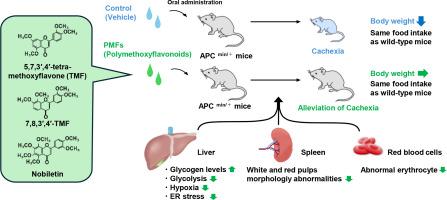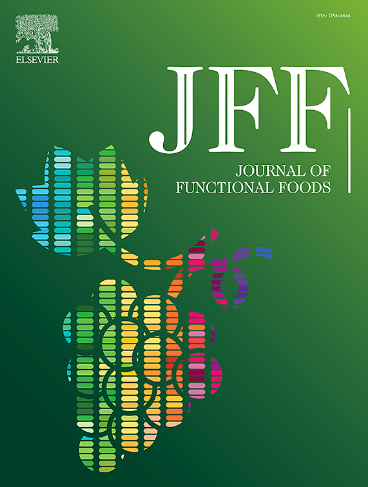Effect of polymethoxyflavones on glucose metabolism in a mouse model of cachexia with mutation in the adenomatous polyposis coli gene
IF 4
2区 农林科学
Q2 FOOD SCIENCE & TECHNOLOGY
引用次数: 0
Abstract
Mice carrying a mutation in the adenomatous polyposis coli (APC) gene (APCmin/+) exhibit cachexia symptoms, including abnormalities in hepatic glucose metabolism, which are associated with endoplasmic reticulum (ER) stress. APCmin/+ mice are widely known to be associated with abnormalities in the Wnt/β-catenin pathway and gastrointestinal polyp formation. It is unclear whether abnormalities in the Wnt/β-catenin pathway are associated with cachexia in APCmin/+ mice. In this study, we orally administered polymethoxyflavonoids (PMFs) such as 5,7,3′,4′-tetramethoxyflavone (TMF), 7,8,3′,4′-TMF, or Nobiletin, to APCmin/+ mice, and analyzed their effects on cachexia symptoms. We found that APCmin/+ mice gradually lost weight, which was suppressed in the group that was administered PMFs. Furthermore, administration of these PMFs improved abnormal glucose metabolism in APCmin/+ mice. Our results suggest that the improvement in glucose metabolism observed in APCmin/+ mice orally administered PMFs is mediated by normalization of glycolysis or alleviation of hypoxia-induced ER stress.

多甲氧基黄酮对大肠腺瘤性息肉病基因突变恶病质小鼠模型葡萄糖代谢的影响
携带大肠腺瘤性息肉病(APC)基因(APCmin/+)突变的小鼠表现出恶病质症状,包括与内质网(ER)应激相关的肝糖代谢异常。众所周知,APCmin/+小鼠与Wnt/β-catenin通路异常和胃肠道息肉形成有关。目前尚不清楚Wnt/β-catenin通路异常是否与APCmin/+小鼠的恶病质相关。在本研究中,我们给APCmin/+小鼠口服多甲氧基黄酮(PMFs),如5,7,3 ',4 ' -四甲基甲氧基黄酮(TMF), 7,8,3 ',4 ' -TMF或诺百列素,并分析它们对恶病质症状的影响。我们发现APCmin/+小鼠体重逐渐减轻,在给予PMFs的组中体重受到抑制。此外,这些PMFs可改善APCmin/+小鼠的异常糖代谢。我们的研究结果表明,在APCmin/+小鼠中,口服PMFs观察到的糖代谢改善是通过糖酵解正常化或缺氧诱导的内质网应激缓解介导的。
本文章由计算机程序翻译,如有差异,请以英文原文为准。
求助全文
约1分钟内获得全文
求助全文
来源期刊

Journal of Functional Foods
FOOD SCIENCE & TECHNOLOGY-
CiteScore
9.60
自引率
1.80%
发文量
428
审稿时长
76 days
期刊介绍:
Journal of Functional Foods continues with the same aims and scope, editorial team, submission system and rigorous peer review. We give authors the possibility to publish their top-quality papers in a well-established leading journal in the food and nutrition fields. The Journal will keep its rigorous criteria to screen high impact research addressing relevant scientific topics and performed by sound methodologies.
The Journal of Functional Foods aims to bring together the results of fundamental and applied research into healthy foods and biologically active food ingredients.
The Journal is centered in the specific area at the boundaries among food technology, nutrition and health welcoming papers having a good interdisciplinary approach. The Journal will cover the fields of plant bioactives; dietary fibre, probiotics; functional lipids; bioactive peptides; vitamins, minerals and botanicals and other dietary supplements. Nutritional and technological aspects related to the development of functional foods and beverages are of core interest to the journal. Experimental works dealing with food digestion, bioavailability of food bioactives and on the mechanisms by which foods and their components are able to modulate physiological parameters connected with disease prevention are of particular interest as well as those dealing with personalized nutrition and nutritional needs in pathological subjects.
 求助内容:
求助内容: 应助结果提醒方式:
应助结果提醒方式:


